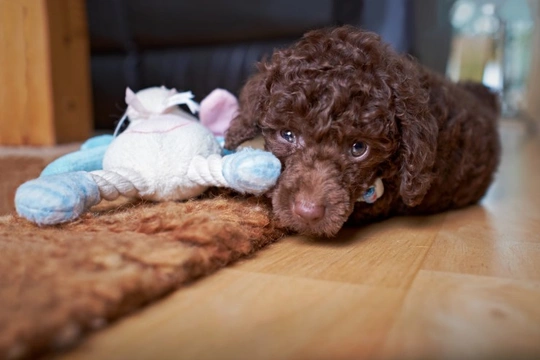
Nipping signs of resource guarding in the bud while your puppy is young
One concept that all dog owners are familiar with is the fact that puppies get given a lot of leeway when it comes to their behaviour, both from people and from adult dogs. This is both natural and understandable, as of course puppies are still learning and will make the odd mistake or push things a little bit too far!
However, failing to address the early stages of a problem in the making, or failing to set firm rules from the get-go when it comes to pups can cause a lot of problems later on: Case in point, it is really cute when a tiny puppy jumps up at you in excitement, but this is not something that you should ever encourage, as it is annoying and possibly dangerous in the adult dog!
One of the main problems that can quickly develop in puppies and one that is also one of the most serious and potentially dangerous behavioural problems if it is allowed to continue when the dog is older is resource guarding, which means taking ownership of certain things such as toys or food, and responding aggressively when approached, or if you try to take the item off the dog.
Dealing with this problem when your dog is still little and preventing it from developing into an acute and potentially dangerous issue is vital, and much easier than trying to sort out the issue that has arisen when it has already become an established behaviour pattern.
In this article, we will look at how to go about stopping the early indications of resource guarding in your puppy, before they become a serious problem. Read on to learn more.
Early warnings
Partially because puppies tend to get given more leeway than adult dogs and also because problems such as resource guarding develop slowly, escalating over time, it can be difficult to identify the signs of resource guarding at their inception. However, knowing what to look out for can help you there!
Puppies do of course like to play with anything they can get their teeth into, and they should have a good range of toys that are theirs, and which they are allowed to take ownership of. However, if your puppy responds to your approach by running off with a toy or grabbing a toy that they were not playing with in an attempt to keep it from you rather than play with it, you may have a problem in the making. Other signs can include being unwilling to drop a toy when asked, or growling at you when you try to take a toy, or even get too close!
Your dog’s mealtimes might provide another area for observation too; if your dog is a puppy and you know their history, the chances are that you will know for a fact that they have never had to fear going hungry or having their food taken away by another dog, and so they should not exhibit any concerns or aggression about their food.
If your puppy growls when you approach them while eating, eats faster when you are around, or even snaps at you, this too can indicate a problem.
While any dog can of course begin to develop resource guarding behaviours or aggression, guarding breeds and dog breeds that tend to be very territorial are those most likely to display such behaviours, such as the Japanese Akita and the Boerboel.
How to resolve the problem before it escalates
You must begin to sort out the problems that are developing before they become a problem, and this means approaching things from several different angles simultaneously.
First of all, teach your dog the “leave it” command, and ensure that they know what it means. Using treats to teach this will help to build up associations in your dog’s mind that doing what they are told when it comes to giving things up and accepting people intervening comes with a trade-off for a better reward, such as a treat.
If your dog growls or snaps, tell them “No!” sharply, and do not engage with them, look directly at them, or give them any attention until they drop the toy.
When it comes to aggression around meals, you need to teach your puppy that having people around when they are eating is ok, and not a threat. In order to do this, you should start in close proximity to the food bowl, rather than putting food into it, walking away and later approaching.
Place the food bowl on the floor at your feet, and allow your dog to eat from it whilst you stand there. Over time, and when you are confident that your pup is not going to snap or be potentially dangerous when guarding their food, you can work up to placing the bowl in your lap whilst you are sitting down.
You might also want to try feeding your dog part of their meal by hand before you put their bowl down, or placing the empty bowl on the floor and decanting a little of their meal into it in stages, so that your pup comes to learn that having people around food means that they get given something, rather than having something taken away!
If you aren’t getting on very well on your own, if you have children at home or if your dog is big or strong enough that they might pose a danger, you may need to enlist the help of a professional canine behaviourist to work with you for a few sessions.
Taking care of resource guarding and aggression is always much easier to do when you first spot the problem instead of later on, so don’t hang about when it comes to getting to work!



